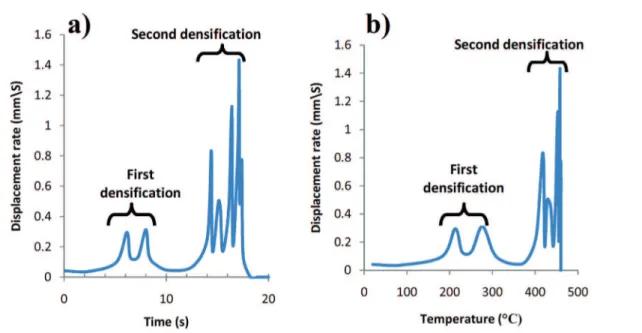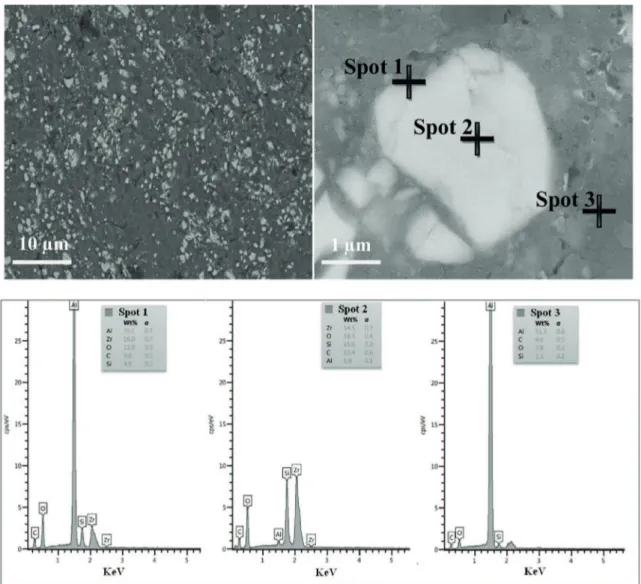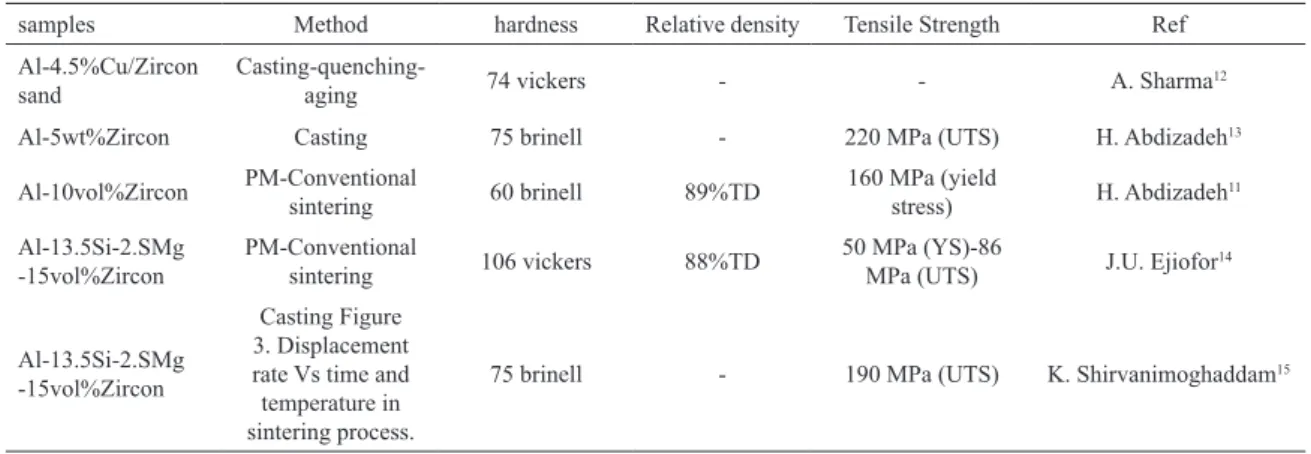DOI: http://dx.doi.org/10.1590/1980-5373-MR-2016-0395
Materials Research. 2016; 19(5): 1189-1192 © 2016
Low Temperature Sintering of Aluminum-Zircon Metal Matrix Composite Prepared by
Spark Plasma Sintering
Ehsan Ghasalia, Hossein Nouraniana, Ali Rahbaria, Houdsa Majidiana, Masoud Alizadeha*, Touradj
Ebadzadeha
Received: January 18, 2016; Revised: May 24, 2016; Accepted: August 20, 2016
Aluminum-15 wt. % zircon metal matrix composite was fabricated using spark plasma sintering method at the temperature of 450°C and holding time of 4 min. The bending strength of 284±21 MPa and microhardness of 171±14 Vickers were determined for produced composite. XRD investigations proved that almost no decomposition of zircon particles as reinforcement occurred. SEM studies revealed the homogenous dispersion of reinforcement particles in the aluminum matrix.
Keywords: Aluminum, Zircon, Sintering, Composite materials
* e-mail: m-alizadeh@merc.ac.ir
1. Introduction
Aluminum metal matrix composites (AMCs) have
attractive applications in the ield of automotive, aerospace
and constructive industries due to their proper properties such
as high stifness, strength and very low weight1,2. Previous
studies have shown that the addition of hard ceramic particles such as SiC, A12O3, and TiC could improve the hardness, wear, and abrasion resistance of aluminum alloys. On the other hand, the homogeneous dispersion of reinforcement particles in a metal matrix composite is one of the most important advantages of powder metallurgy compared with casting routs methods3. The key step in powder metallurgy process
(beside others), is sintering. Spark plasma sintering (SPS) technique is one of the high-technology sintering process that has been used to prepare the large number of composite materials4,5. As reported6, SPS introduces two important factors in a process of sintering; irst is the production of
sparks between particles and second is the application of pressure during sintering process. The advantages of SPS method such as rapid heating, surface cleaning of powders, etc, make this process one of the most successful sintering method to obtain fully dense materials7-10.
In the present work, the spark plasma sintering technique has been used to produce Al-Zircon composites at a lower sintering temperature compared with conventional method. Additionally, the mechanical properties and microstructure of prepared composites have been investigated.
2. Materials and method
Aluminum (1056-merck), zircon (99.5% purity, average particle size of 5 µm) powders were used as starting materials. Aluminum and zircon (15 wt. %) powders were mixed in a turbula mixer in ethanol media for 1hours. After mixing,
the mixtures were dried at 70°C to remove ethanol. Then, the dried powders were fed into a circular (30 mm diameter) graphite die. The sintering was performed at temperature of
450°C by applying 10 MPa uniaxial pressure at irst step which
was increased to 40 MPa at maximum operating temperature and remained for 4 min under vacuum. In order to remove the attached graphite, the surface of sintered samples was ground. After cutting the large samples, the bending strength test was measured on samples with the size 25×5×4 mm. The bulk density of sintered samples was measured using
the Archimedes’ principle. X-ray difraction (XRD, Philips
X’ Pert System) analyses were performed to identify the phases present in the aluminum-zircon composites. Vickers microhardness values were determined using a MKV-h21 Microhardness Tester under a load of 1kg for 15 s. Scanning electron microscopy (Sigma / VP, Zeiss) was used to characterize the microstructure of the composites.
3. Results and discussion
The XRD pattern of aluminum-zircon composite sintered at 450°C (Figure 1) exhibits the sharp peaks of aluminum and zircon as the only crystalline phases which imply that on the precision of XRD analysis no decomposition of zircon and also reaction between aluminum and zircon take place. Figure 2 demonstrates the displacement and temperature changes versus sintering time and also Figure 3 illustrates the displacement rate as a function of sintering time and temperature. The change and rate of displacement can be used as the criteria of progress in sintering process. The increase in displacement shown in Figure 2 can occur as the result of two important changes in sintering process: 1) increasing sintering temperature and 2) applying pressure at maximum sintering temperature. By changing these two parameters,
the amount of displacement as a criterion of densiication
Ghasali et al.
1190 Materials Research
Figure 1: XRD pattern of aluminum- zircon composite sintered at 450°C.
Figure 2: Displacement and temperature changes versus sintering time.
Figure 3: Displacement rate Vs time and temperature in sintering process.
reaches a maximum. The maximum displacement of 2.5 mm was measured in the present work. It is worth noting
that the inal stage of sintering process can be distinguished
from the constant change of displacement.
Figure 3 shows the displacement rate of sintering procedure for aluminum-zircon composite. There are two important peak areas for displacement rate which demonstrate two main sintering stages.
These areas were labeled in Figure 3 correlated to irst and second densiication of specimen. The irst area correlates the displacement rate to the inluence of temperature and
also, attributes to gas removal and rearrangement of particles
on densiication while the second area occurs as pressure
increases to 40 MPa.
The backscattered electron images and EDS spectra investigations from composite sample (Figure 4) revealed a homogeneous distribution of reinforcement particles in aluminum matrix. The bright spots in backscattered image represent the reinforcement particles, while the dark areas are aluminum matrix (spot 3 in Figure 4). Spot 1 introduces the existence of aluminum, zirconium, silicon and oxygen elements; this combination of elements shows most likely the existence of zircon and aluminum particles, as XRD
pattern of Figure 1 conirms. It is noticeable that in EDS
spectra shown in Figure 4 a peak of carbon is observable; it is because of using carbon foils in sintering process, therefore
accelerated difusion of carbon atoms into the aluminum
matrix occurs under the SPS conditions.
Table 1 presents relative density, bending strength and microhardness values of prepared composite. A highly dense aluminum-zircon composite was obtained by the present work. The bending strength and microhardness of 284±21 MPa and 171±14 Vickers, respectively, were measured for sintered samples. The mechanical results obtained by our work are in good agreement with other published results
in the ield of aluminum-zircon composite. H. Abdizadeh
et al11 reported the production of aluminum-zircon composite
1191 Low Temperature Sintering of Aluminum-Zircon Metal Matrix Composite Prepared by Spark Plasma Sintering
Table 1: Relative density, bending strength and microhardness of prepared composite.
properties Relative density (%) Bending strength (MPa) Microhardness (Vickers)
Al-Zircon composite 99.3±5 284±21 171±14
Figure 4: SEM images and EDS spectra of aluminum-zircon composite.
for 65 min. The reported relative density and mechanical properties of their work are almost lower than those reported in the present work due to the lower sintering time and temperature during SPS process beside application pressure during sintering process. The mentioned advantages of SPS process yield to better mechanical properties in lower sintering time and temperature.
Table 2 presents mechanical properties and relative density of Al-Zircon composite which investigated by other researchers. As it can be seen in Tables 1 and 2, the mechanical and relative density results of these investigations are higher than other researcher’s works. Application of spark plasma sintering leads to near fully dense Al-Zircon composite with proper microstructure. The lower sintering time and temperature beside PM technique
leads to enhanced properties of composite. The capabilities of SPS method for preparation of aluminum matrix composite with unique properties have been reported by researchers16-18.
4. Conclusions
Ghasali et al.
1192 Materials Research
Table 2: Mechanical properties and relative density of Al-Zircon composite investigated by other researchers.
samples Method hardness Relative density Tensile Strength Ref
Al-4.5%Cu/Zircon sand
Casting-quenching-aging 74 vickers - - A. Sharma
12
Al-5wt%Zircon Casting 75 brinell - 220 MPa (UTS) H. Abdizadeh13
Al-10vol%Zircon PM-Conventional
sintering 60 brinell 89%TD
160 MPa (yield
stress) H. Abdizadeh
11
Al-13.5Si-2.SMg -15vol%Zircon
PM-Conventional
sintering 106 vickers 88%TD
50 MPa (YS)-86
MPa (UTS) J.U. Ejiofor
14
Al-13.5Si-2.SMg -15vol%Zircon
Casting Figure 3. Displacement rate Vs time and temperature in sintering process.
75 brinell - 190 MPa (UTS) K. Shirvanimoghaddam15
5. References
1. Surappa MK. Aluminium matrix composites: Challenges and opportunities. Sādhanā.2003;28(1):319-334.
2. Das S, Udhayabanu V, Das S, Das K. Synthesis and characterization of zircon sand/Al-4.5 wt% Cu composite produced by stir casting route. Journal of Materials Science. 2006;41(14):4668-4677.
3. Geni M, Kikuchi M. Damage analysis of aluminum matrix composite considering non-uniform distribution of SiC particles.
Acta Materialia. 1998;46(9):3125-3133.
4. Mamedov V. Spark plasma sintering as advanced PM sintering method. Powder Metallurgy. 2002;45(4):322-328.
5. Tokita M. Development of large-size ceramic/metal bulk FGM fabricated by spark plasma sintering. Materials Science Forum. 1999;308-311:83-88.
6. M Suárez A, Fernández JL, Menéndez R, Torrecillas HU, Kessel J, Hennicke R, et al. Challenges and Opportunities for Spark Plasma Sintering: A Key Technology for a New Generation of Materials. In: Ertuğ B, ed. Sintering Applications. Rijeka: InTech; 2013. doi: 10.5772/53706.
7. Xie GQ. Sintering process and interfaces microstructure of metal powders by pulse electric current sintering. [PhD Thesis]. Niigata: Niigata University; 2003.
8. Omori M. Sintering, consolidation, reaction and crystal growth by the spark plasma system (SPS). Materials Science & Engineering: A. 2000;287(2):183-188.
9. Ghasali E, Alizadeh M, Ebadzadeh T. Mechanical and microstructure comparison between microwave and spark plasma sintering of Al-B4C composite. Journal of Alloys and Compounds. 2016;655:93-98.
10. Ghasali E, Pakseresht A, Safari-kooshali F, Agheli M, Ebadzadeh T. Investigation on microstructure and mechanical behavior of Al–ZrB2 composite prepared by microwave and spark plasma sintering. Materials Science & Engineering: A. 2015;627:27-30.
11. Abdizadeh H, Ashuri M, Moghadam PT, Nouribahadory A, Baharvandi R. Improvement in physical and mechanical properties of aluminum/zircon composites fabricated by powder metallurgy method. Materials & Design. 2011;32(8-9):4417-4423.
12. Sharma A, Das S. Study of age hardening behavior of Al–4.5 wt%Cu/zircon sand composite in diferent quenching media – A comparative study. Materials and Design. 2009;30(9):3900-3903.
13. Abdizadeh H, Baharvandi HR, Shirvani Moghaddam K. Comparing the efect of processing temperature on microstructure and mechanical behavior of (ZrSiO4 or TiB2)/aluminum composites.
Materials Science and Engineering: A. 2008;498(1-2):53-58.
14. Ejiofo JU, Okorie BA, Reddy RG. Powder processing and properties of zircon-reinforced Al-13.5Si-2,5Mg alloy composites. Journal of Materials Engineering and Performance. 1997;6(3):326-334.
15. Shirvanimoghaddam K, Khayyam H, Abdizadeh H, Karbalaei Akbari M, Pakseresht AH, Abdi F, et al. Efect of B4C, TiB2 and
ZrSiO4 ceramic particles on mechanical properties of aluminium matrix composites: Experimental investigation and predictive modelling. Ceramics International. 2016;42(5):6206-6220. doi: http://dx.doi.org/10.1016/j.ceramint.2015.12.181.
16. Ghasali E, Pakseresht A, Rahbari A, Eslami-shahed H, Alizadeh M, Ebadzadeh T. Mechanical properties and microstructure characterization of spark plasma and conventional sintering of Al-SiC-TiC composites. Journal of Alloys and Compounds. 2016;666:366-37.
17. Saheb N, Iqbal Z, Khalil A, Hakeem AS, Al Aqeeli N, Laoui T, et al. Spark plasma sintering of metals and metal matrix nanocomposites: a review. Journal of Nanomaterials. 2012;2012:983470.


